I know, I use that phrase constantly when describing how I want the gardens I designed to look in the fall. But seriously, isn't it the most beautiful thing?!!
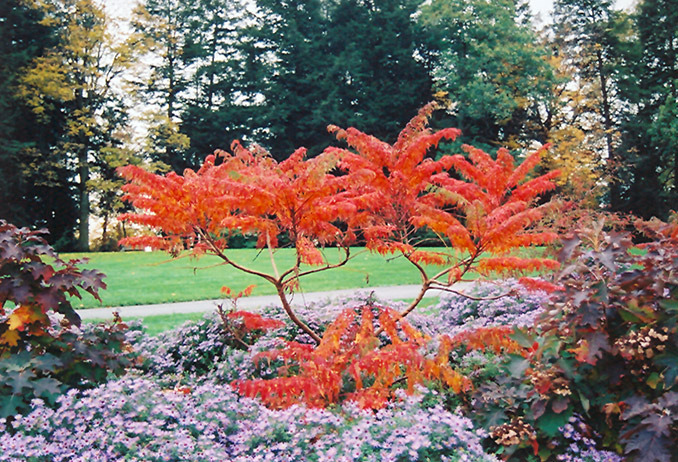

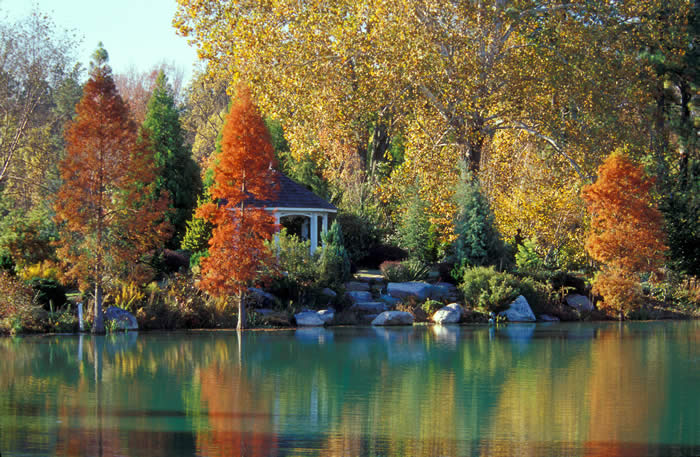
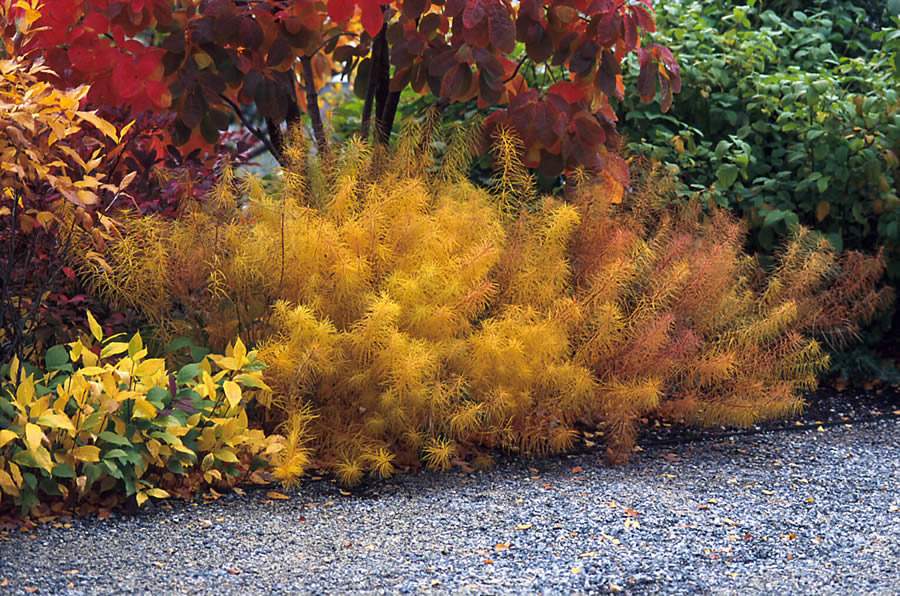
I know, I use that phrase constantly when describing how I want the gardens I designed to look in the fall. But seriously, isn't it the most beautiful thing?!!




Geums have a color palette that complements just about any garden. They're colorful, cheerful and easy to grow, with flowers that remind you a little of strawberry plants. The rosette-shaped flowers are generally borne on long stems, rising above the thick clump of semi-evergreen foliage that creates a welcome, fresh presence in spring.
Yellows and oranges with some reds and apricots, their color palette is soft enough not to take center stage, but interesting enough to make you look twice. Most geums require a soil that does not become too dry during summer, and they don’t mind a certain amount of shade.
'Flames of Passion' - flowers vary from single to semi-double, from non-frilly to frilly, with lovely soft coral orange/pink flowers that are held above a dense clump of light green leaves. Flowers from April to June.

Geum X 'Flames of Passion'
'Mango Lassi' - This nice plant has small, semi-double yellow flowers that are heavily stained with red rendering them soft orange. The flowers are held on short stems above a mound of mid-green, evergreen leaves. This cultivar was discovered by Grace Dinsdale on her nursery in Oregon as a sport of the single yellow flowered geum ‘Georgenberg’. Flowers May to July.

Geum 'Mango Lassi'
'Totally Tangerine' - a soft orange in late spring that pulls together the purples and whites. Flowers May - June, then sporadically in fall if you deadhead it.
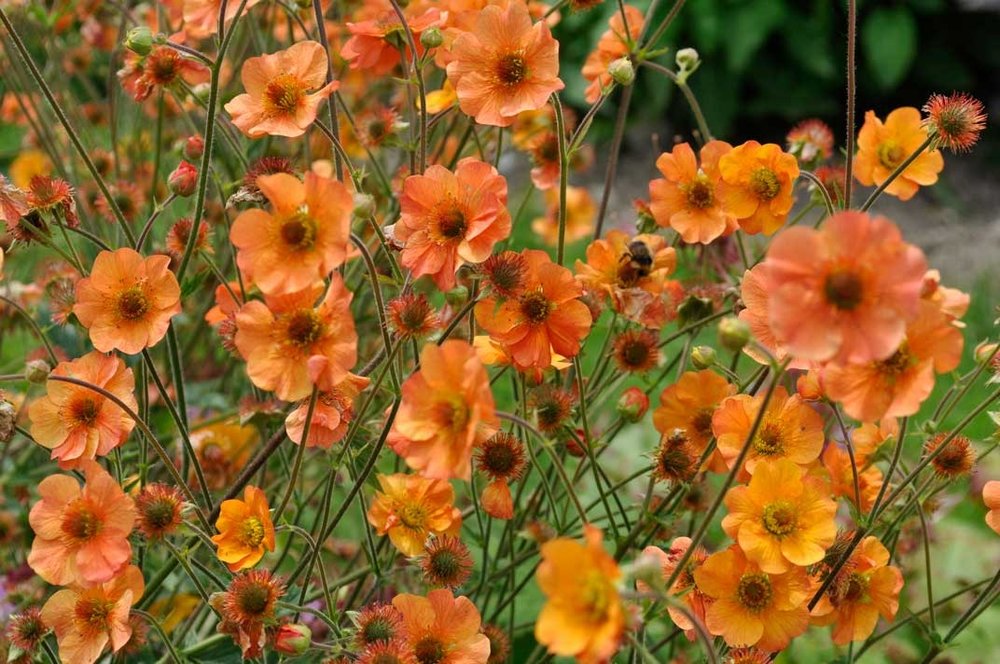
Geum 'Totally Tamgerine'
'Mai Tai' - A new variety with open semi-double soft apricot flowers with neatly ruffled petals that form a rosette on short, branched stems. Raised by Brent Horvath of Intrinsic Perennial Gardens in the USA. Flowers from May until July.
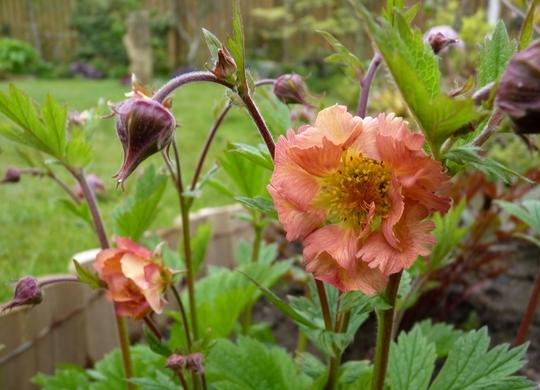
Geum 'Mai Tai'
'Prinses Juliana' is a new introduction with semi-double bright orange flowers. Blooms April - June.
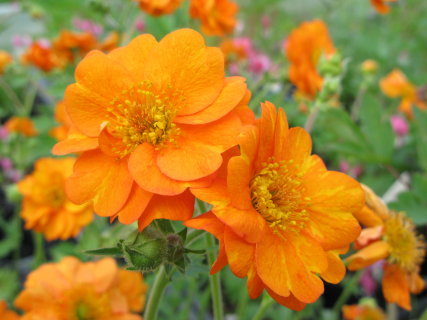
Geum 'Prinses Irene'
'Mrs J Bradshaw' - is a red cultivar - not red like crocosmia 'Lucifer', but still red enough to contrast with purple and make yellow stand out. Blooms May - June.
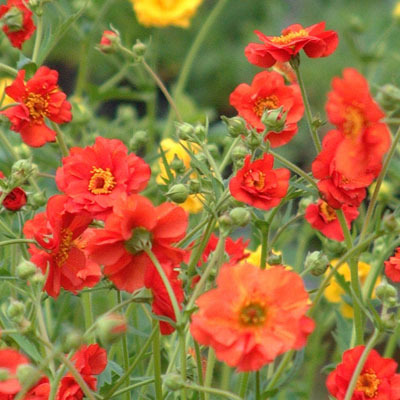
Geum 'Mrs J Bradshaw'
'Lemon Drops' - is a cultivar of Geum rivale, so its flowers are more nodding than some of the other cultivars. Its a beautiful shade of yellow, and short - growing to only 9 inches. Flowers May - July.
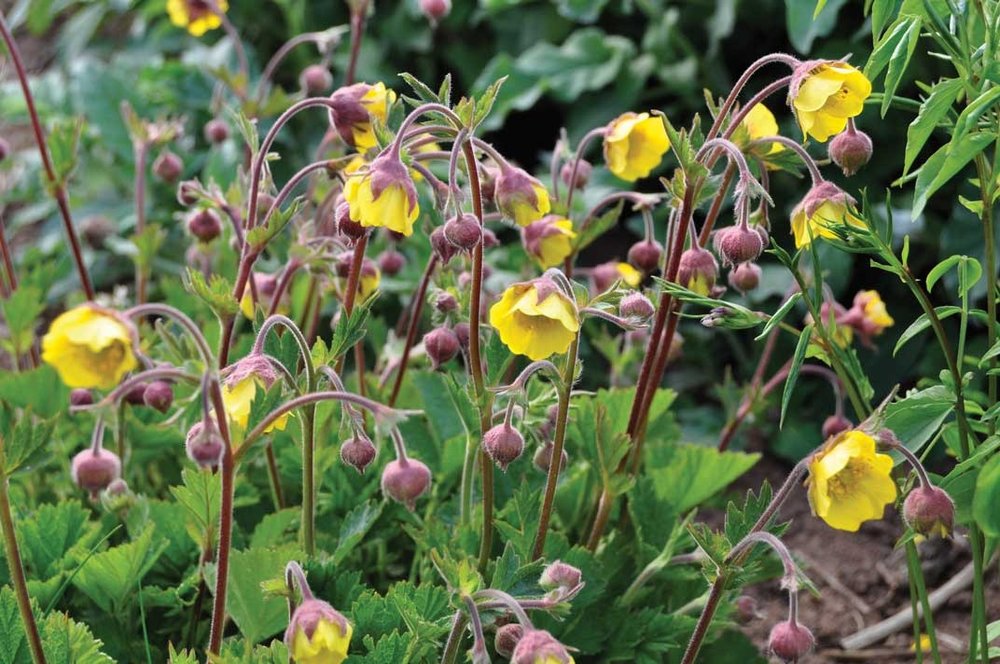
Geum 'Lemon Drops''Beech House Apricot' is a low-grower that flowers from May - July and can make itself right at home in the front of the border - only 8 inches tall.
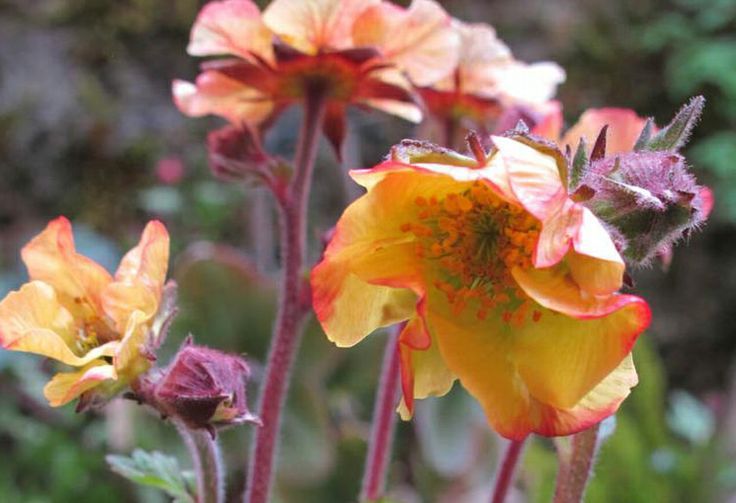
Geum 'Beech House Apricot'
From the ASLA Blog "The Dirt":
08/11/2014 by Jared Green

Browsing through the latest issue of Azure magazine, (http://www.azuremagazine.com/) one can see socially conscious design is making its way even into the far reaches of Winnipeg, Canada. Folly Forest (http://www.csla-aapc.ca/awards-atlas/folly-forest), a great, small project at the Stratchona School, which in a low-income neighborhood, was put together with just $80,000 by local design firm Straub Thurmayr Landscape Architects and Urban Designers.
50-year old asphalt was broken apart so 100 trees could be planted within bright red and yellow-lined star-shaped spaces. Azure tells us: “To add rich texture and provide ground cover for the new plantings, they arranged bricks, logs, and stones inside the bases.”

The project has deservedly taken home a ton of Canadian design awards. Azure‘s jury gave it a merit award, and the Canadian Society of Landscape Architects (CSLA) awarded it a citation (http://www.csla-aapc.ca/awards-atlas/folly-forest). CSLA said the project “demonstrates the immense potential of landscape architecture as a spatial and social transformer. It showcases how a simple measure can take ecological and aesthetic effects and turn them into the formative element of design.”
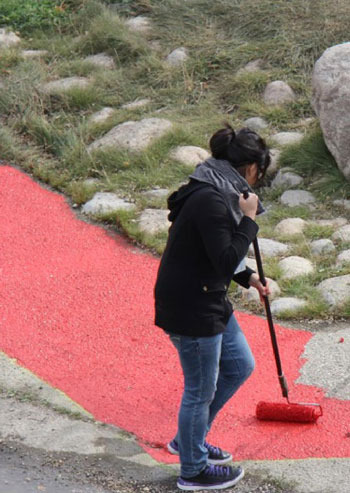
The Prairie Design Awards (http://www.prairiedesignawards.com/2014/folly_forest.html) also honored the project, writing that at just $20 per square foot, nature is allowed to “take root through an asymmetrically disposed composition of newly planted trees, benches, follies and earthen mounds. The program fosters playful engagement, through the eyes of a child, and provides any visitor, young or old, to engage with a truly delightful and special place.”
But beyond all the accolades from the design world, the teachers and kids at the school seem to get a lot of out their rugged new green space, too. Erin Hammond, a teacher at Stratchona School, told CBC News (http://www.cbc.ca/news/canada/manitoba/strathcona-school-perforates-tarmac-to-create- folly-forest-1.1352450), the new space has been a boon for the kids. “It’s just been an amazing enticement to get kids outside.”
Teachers are using the green space to start new conversations about ecology. “Kids are going, ‘How come that tree has more leaves than this one?’ Well, that one has more sun than this one,” said Hammond.
I recently joined the Soil Science Society of America. They have published a fabulous book called 'Know Soil Know Life" - designed as a textbook for middle/high school students. Here's some of the points they make.
Soils Overview - Provided by the Soil Science Society of America
Soils are complex mixtures of minerals, water, air, organic matter, and countless organisms that are the decaying remains of once-living things. It forms at the surface of land – it is the “skin of the earth.” Soil is capable of supporting plant life and is vital to life on earth.
Soil is formally defined by the Soil Science Society of America as : "the unconcolidated mineral or organic material on the immediate surface of the earth that serves as the natural medium for the growth of land plants". The second part of the definition is "the unconcolidated mineral or organic matter on the surface of the earth that has been subjected to and shows effects of genetic and environmental factors of: climate (including water and temperature effects), and macro- and microorganisms, conditioned by relief, acting on parent material over a period of time.
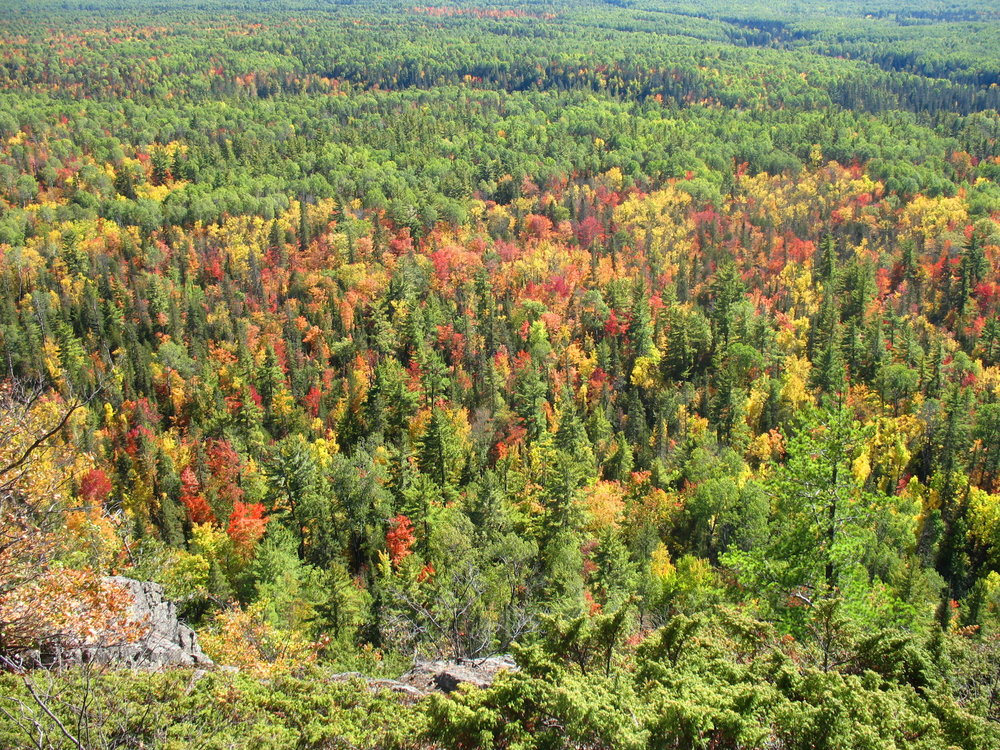
So, then, what is DIRT?
Dirt is what gets on our clothes or under our fingernails. It is soil that is out of place in our world – whether tracked inside by shoes or on our clothes. Dirt is also soil that has lost the characteristics that give it the ability to support life – it is “dead.”
Soil performs many critical functions
in almost any ecosystem (whether a farm, forest, prairie, marsh, or suburban watershed). There are seven general roles that soils play:
1. Soils serve as media for growth of all kinds of plants.
2. Soils modify the atmosphere by emitting and absorbing gases (carbon dioxide, methane, water
vapor, and the like) and dust.
3. Soils provide habitat for animals that live in the soil (such as groundhogs and mice) to organisms (such as bacteria and fungi), that account for most of the living things on Earth.
4. Soils absorb, hold, release, alter, and purify most of the water in terrestrial systems.
5. Soils process recycled nutrients, including carbon, so that living things can use them over and
over again.
6. Soils serve as engineering media for construction of foundations, roadbeds, dams and buildings, and preserve or destroy artifacts of human endeavors.
7. Soils act as a living filter to clean water before it moves into an aquifer.

Understanding "the basics" of soil is no small matter. One of the most basic problems with soil is compaction. For many of my clients, the soil around their homes has been virtually ruined by what took place when their house was built or renovated. Many (all?!) builders/contractors think of soil as dirt and make no effort to protect it or renovate it after they're finished. Around here, most of the new development is infill development, so virtually the whole lot is disturbed - by tearing down the old house, by cutting down all the trees, by building an addition, by installing a pool. Their machines churn across what might have been relatively undisturbed soil, often when the soil is saturated after a hard rain, creating ruts that are virtually impossible to correct. They dig a new foundation and turn the existing soil-profile upside down in doing so. What used to be subsoil is now on top. When they're done, they flatten out the clay-ey subsoil, put back a couple inches of the "topsoil" that they allegedly scraped off at the beginning (is it full of weed seeds now?? has it been tested? what is its texture? has compost been added?), throw down some "contractor's mix" el-cheapo grass seed and poof - there's your new lawn! This is what we refer to as "urban soil".
Urban soils are typically inhospitable places for trees, other plants, and their oxygen breathing microorganisms. Human activities, such as those described above, as well as grading and even foot traffic leave urban soils much more compacted than natural soils. Typically 40-55% of the volume in a healthy forest soil consists of pore space. This pore space consists of varying proportions of air and water depending on the weather. With compaction, soil particles are pushed together and fill up pore spaces, so pore space in urban soils often goes down to 20-30%.
Spring is here and it reminds me again of the rewards of planting spring-flowering bulbs in fall. I've often said "It's the best hour you'll ever spend". OK, maybe more than an hour. If you have a deer problem, there are still plenty of spring-flowering bulbs that you could be admiring right now in your garden - daffodils, alliums, scilla, leucojum, galanthus ...You can also plant bulbs in large containers that are left outoodrs over the winter. Here's some of what I installed in containers last year:
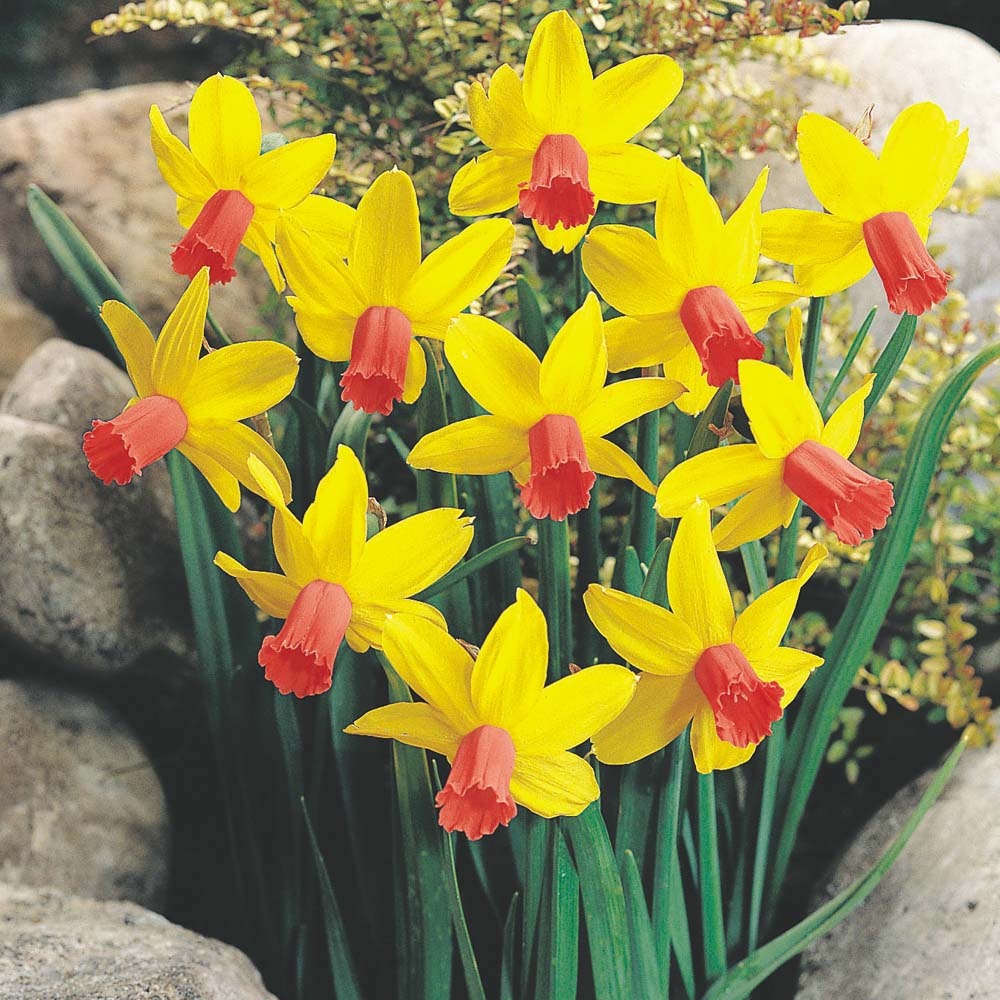
Narcissus 'Jetfire' flowers early and perks up containers.
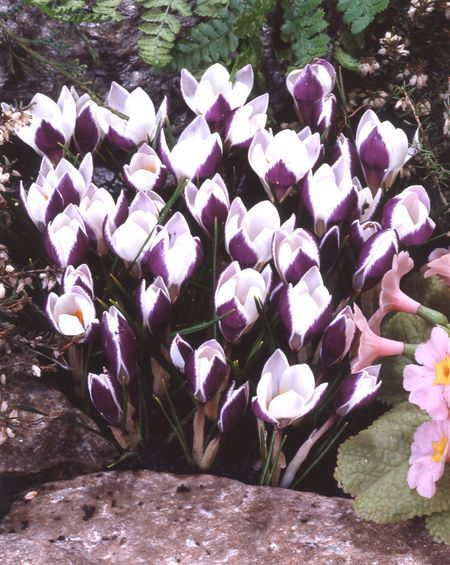
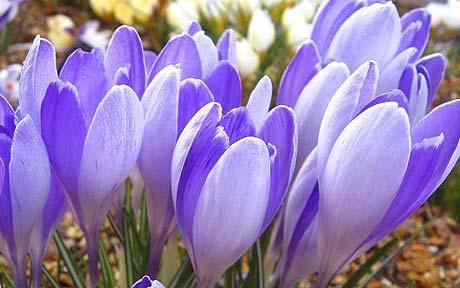
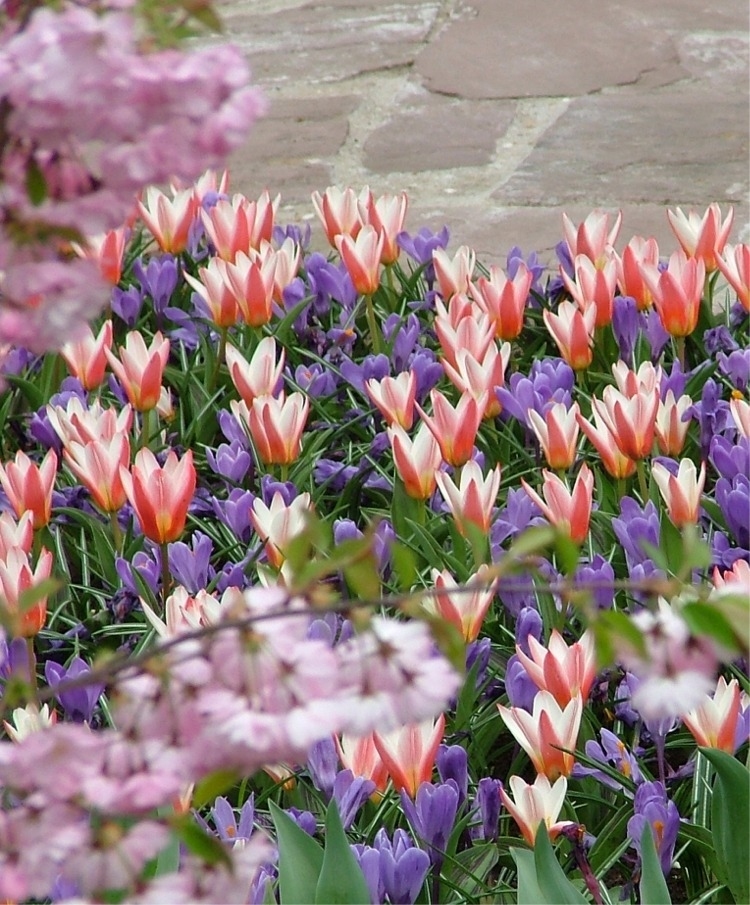
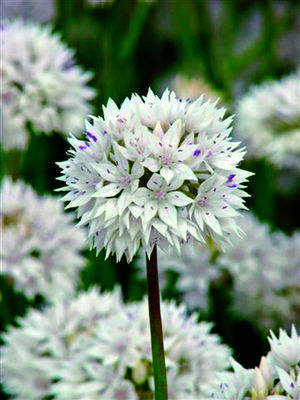
Crocus chrysanthus 'Ladykiller'Crocus X vernus 'Vanguard'Tulipa kaufmanniana 'Heart's Delight'Allium X 'Graceful'
The Perennial Plant of the Year is chosen by the Perennial Plant Association for its suitability for a wide range of growing climates, low maintenance, multiple seasons of interest and relative disease/pest resistance.
2014 Panicum virgatum 'Northwind' (Switchgrass) - a native warm-season grass with an upright form, blue-green leaves and gold fall color. Like all Panicum (but different from some other warm-season grasses, the grass flowers are held just above the leaf blades. For more details, check out the PPA website - it will tell you some of the great attributes of switchgrass for your garden.

Panicum virgatum 'Northwind'

The Cary Award is given to trees, shrubs and vines ("woodies") with multiple seasons of interest and good disease and pest resistance. It is administered by the Tower Hill Botanic Garden. The purpose of the award is:
To inform home gardeners which plants would be good choices in their landscape, to instill confidence in the home gardener's selection, and to increase the diversity of plant material used by gardeners, landscape designers and architects.
The Cary Award has declared 2014 The Year of the Vine, and has selected three vines suitable for trellises, pergolas, porches, walls and anywhere else you need a climber.
Clematis X 'Betty Corning' (C. crispa X C. viticella) is a late, small-flowered clematis that was first discovered in Albany NY in 1932. It grows to about 6' tall and has nodding bell-shaped pale lavender flowers with recurved tips. It flowers freely from June to Sept. It needs only a little tying to grow well on a trellis, and can also be used as a ground cover if you're feeling adventurous - let it wind through your perennial border. It should be pruned back in late winter-early spring, and can be cut back all the way to the ground without losing the season's flowers.

Clematis 'Betty Corning'
Actinidia kolomikta (Variegated Hardy Kiwi Vine) - a relatively fast-growing deciduous woody vine which grows to about 15 - 20', is grown mainly for its foliage and its bark. It has variegated pink and white young leaves, fragrant white flowers in spring and peeling cinnamon-colored bark in winter. This species has both male and female plants - both are needed for pollination. The male plant has better leaf variegation - but 1' long greenish-yellow edible fruits are produced on the female plant in early fall.
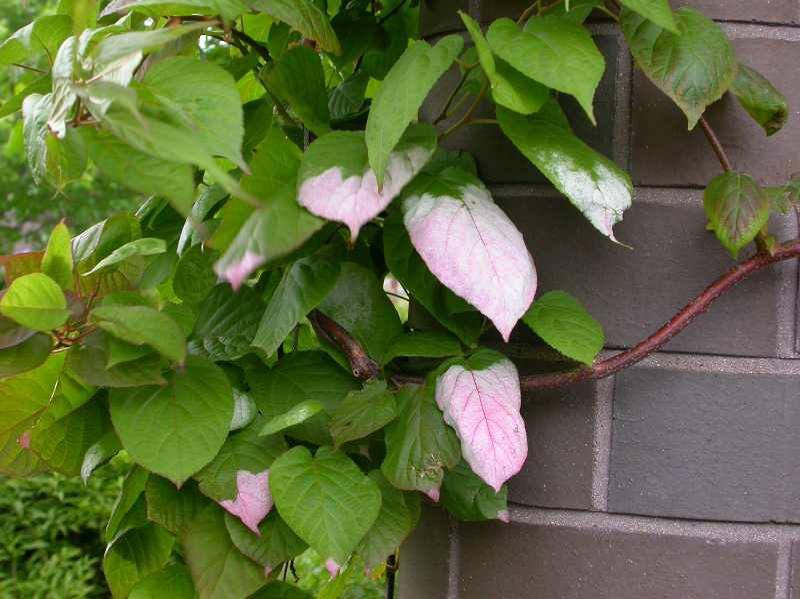
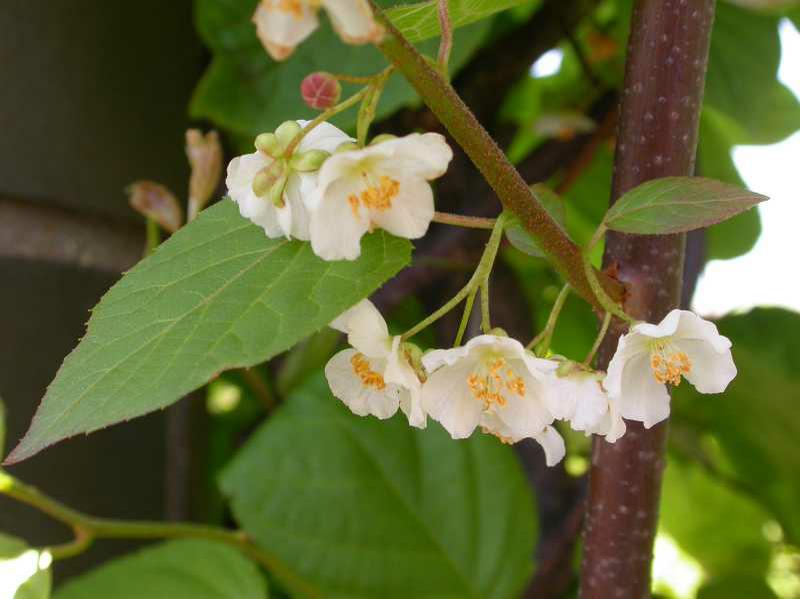
Hardy Kiwi VineFlowers of the hardy kiwi are obscured by the foliage, but are fragrant
Wisteria frutescens (American wisteria) - a twining woody vine that grows to 40' or more - but the good news is that it is a less aggressive spreader than Wisteria sinensis (Chinese wisteria). It flowers in April - May with fragrant, pea-like flowers in drooping 6" racemes, and may re-bloom on new wood in the summer. Flowers give way to flattened smooth seed pods that ripen in summer. Thebest flowering occurs in full sun.
Vines can take up to 3 years before flowering after they are planted, and they need regular pruning to control size and shape, as well as to encourage flowering. Don't choose this vine if you're impatient or prune-o-phobic. Also, take care where you plant it - it doesn't like to be transplanted very much. Failure of vines to flower can be caused by death of the flower buds during a harsh winter, too much shade, plants being too young, improper pruning or over-fertilization (which favors leaf growth over flower-bud formation). The two most common cultivars to be found in the Nursery trade are 'Amethyst Falls', with lavender flowers, and 'Nivea', with white flowers.
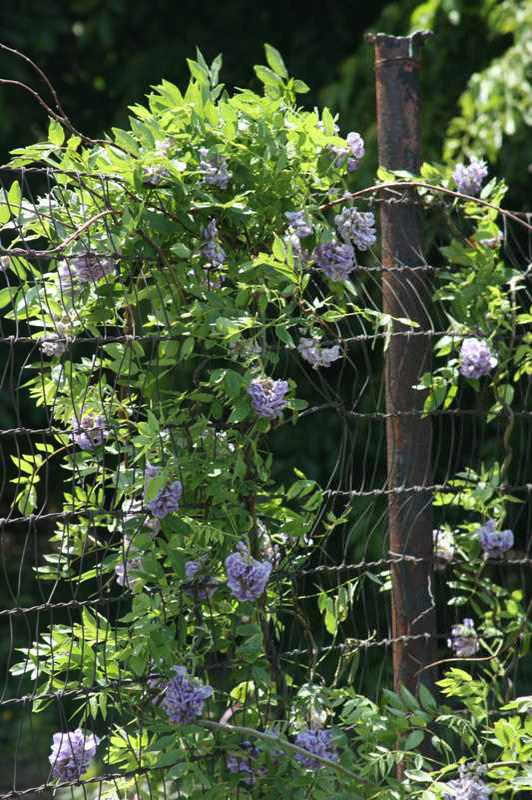
Wisteria frutescens 'Amethyst Falls'
All-America Selections honor new plants, including vegetables and annuals. For 2014, one of their selection is Guara 'Sparkle White', a perennial in Zone 6 and above, that flowers all season. It is a delicate plant with very clean white flowers that wave in the breeze above the foliage. A really nice addition to the perennial border - or use it in your containers.

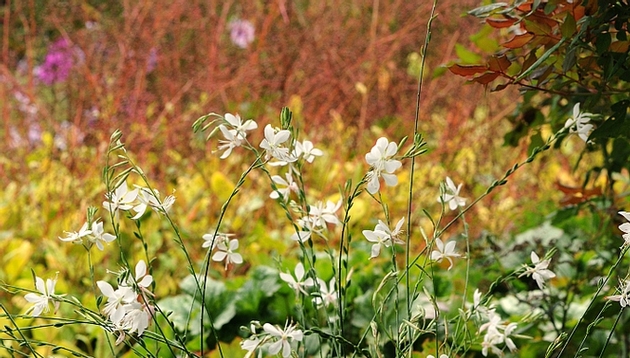

The Society of Municipal Arborists has chosen Parrotia persica 'Vanessa' (Persian ironwood or Persian witchhazel) as the 2014 Urban Tree of the Year. The SMA selects trees that are adaptable to a variety of harsh growing conditions with strong ornamental traits. Their selections are being used as street trees in some towns and cities across the country. The SMA's mission is to widen the knowledge base of arborists, designers and architects with the goal of adding diversity as well as beauty to the urban streetscape.
The 'Vanessa' cultivar has a number of qualities that make it desirable as a street tree: it is slow-growing, reaching a mature height of about 30'; it has an upright, almost columnar habit but has strong branch unions and is not prone to develop included bark (as some other columnar trees are); it handles reduction pruning fairly well, so its height can be managed by knowledgable municipal arborists if overhead wires are low; it has no major pests; it can tolerate both dry soils and seasonally wet ones. PLUS it has spectacular fall color and beautiful flakey gray bark. It flowers in late winter, before it leafs out - like witchhazel - but that can be an unexpected surprise for passers-by.

Parrotia persica 'Vanessa' fall foliage
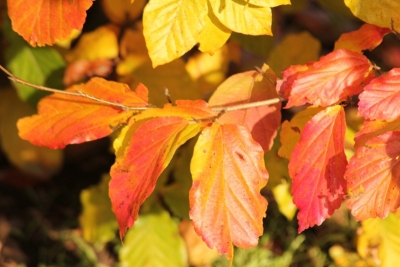
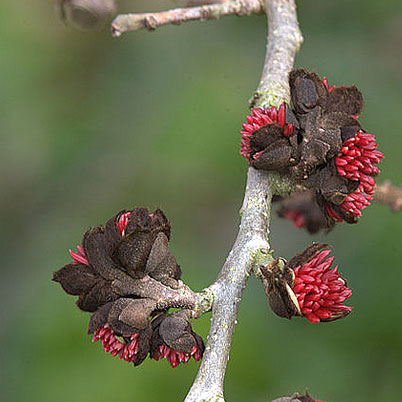

Parrotia flowers in late winterParrotia bark becomes more beautiful as it matures
More from the NYS Arborist Meeting in January:
Mr. Hendrickson, the guru from Bartlett Tree Research, mentioned a magic ingedient in passing that I didn't know anything about - biochar. It turns out that biochar has a rich history (no pun intended) as a soil amendment that "magically" makes plants and trees grow and that even helps soil structure and health.

Here are some facts:
Biochar is formed from organic material (otherwise know as garden waste) by pyrolysis: a thermochemical decomposition of organic material at high temperatures (390 - 570 degrees F) in the absence of oxygen. It involves the simultaneous change of chemical composition and physical phase, and is irreversible. The word is coined from the Greek-derived elements pyro "fire" and lysis "separating". In general, pyrolysis of organic substances produces gas and liquid products and leaves a solid residue richer in carbon content, char - aka biochar. Pyrolysis differs from other high-temperature processes like combustion and hydrolysis in that it doesn't involve reactions with oxygen or water.
Biochar as a soil amendment has an ancient precedent - "terra preta", discovered in the 1950s by Dutch soil scientist Wim Sombroek in the Amazon rainforest. It still covers 10 percent of the Amazon Basin. As the nonprofit U.S. Biochar Initiative explains, “biochar has been created and used by humans in traditional agricultural practices in the Amazon Basin of South America for more than 2,500 years. Dark, charcoal-rich soil (known as terra preta, or black earth) supported productive farms in areas that previously had poor and, in some places, toxic soils".
Over the past 10 years, researchers have been investigating terra preta, now called biochar, as an agricultural resource. Typically when biomass decomposes or burns, virtually all of the carbon stored in the plant is released into the atmosphere as carbon dioxide, a greenhouse gas that contributes to global warming. But when biochar is produced, roughly half of the plant’s carbon is retained as stable carbon in the biochar. The other half is released as wood gases, which can be used as an energy source. This biochar cycle puts carbon from the atmosphere back into the earth, puts it to positive use in the soil and increases the amount of time it stays there.
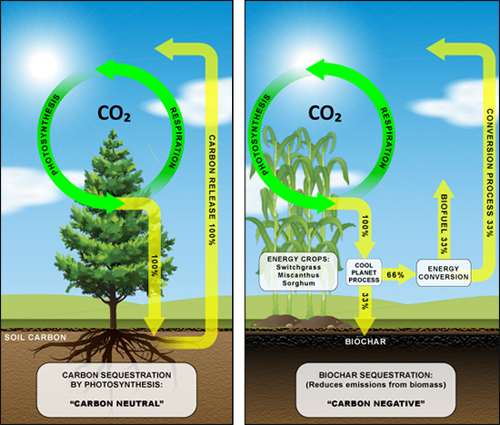
Here's why biochar is "magic":
"What is special about biochar is that it is much more effective in retaining most nutrients and keeping them available to plants than other organic matter such as for example leaf litter, compost or manures. Interestingly, this is also true for phosphorus which is not at all retained by 'normal' soil organic matter". (Lehmann, 2007)
from Cornell webpage; references as cited on that page
But there are caveats as well:
Here are some of the initial findings that Bartlett Tree Research Laboratories and the Morton Arboretum have publicized for biochar:
To find out more:
soils.org is an interesting website - this link will lead you to a story about the Morton Arboretum work on tree growth using biochar
And, of course,Cornell has a lot of expertise - this link will provide you with both information and lots of references
Looking back to 2013, its been a year of crazy weather and rapacious weeds. It sems like "crazy weather" may be the "new normal". If next summer is anything like this past one, invest in brown paper leaf bags - there will be lots of garden clean-up to be done. And here's hoping that we didn't allow some of the thugs to set seed.
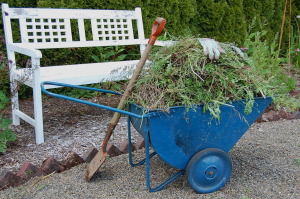
Speaking of thugs, my advice is don't plant goldenrod in your small or small-ish perennial garden. It is quite the spreader and you'll be hard-pressed to get rid of it after a couple of seasons, but you'll want to because it will obliterate your "design". If you have an area you want to "fill" with something native, or have a wild garden or an edge habitat with the right conditions, plant it there. It tolerates clay-ey soil, wet soil, and even some shade, and it's deer-resistant. Before you know it you'll have a nice patch of yellow flowers in fall. But figure out what it looks like before it flowers and remove self-seeded plants from your perennial border and/or keep it in check. You can always give a divison to your friends ..... but please forewarn them!
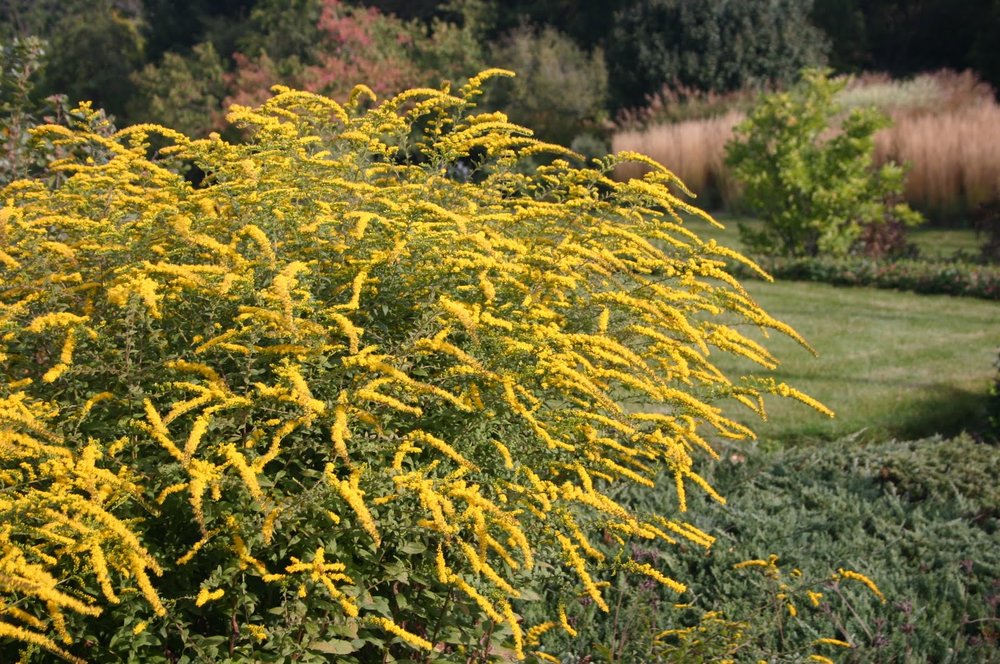
Solidago rugosa 'Fireworks'

Solidago rugosa 'Fireworks' just before flowering - learn to recognize perennials before they flower so that you can effectively manage them
As winter comes, enjoy the snow-covered "bones" of your garden. Maybe even decorate one of your outdoor evergreens for the season.

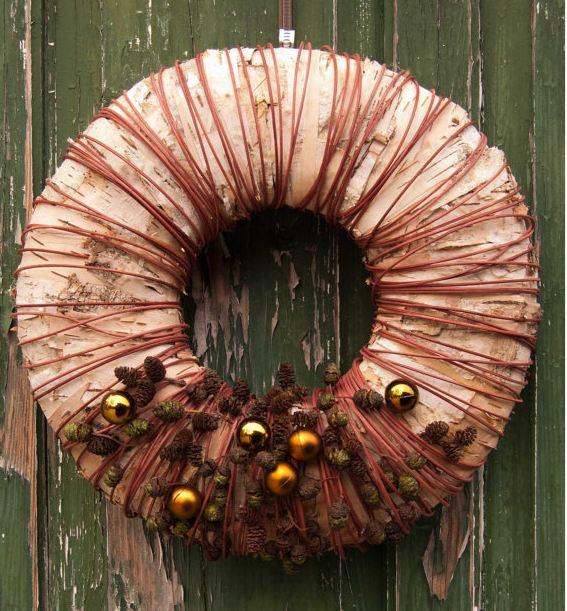
… is planting spring-flowering bulbs.
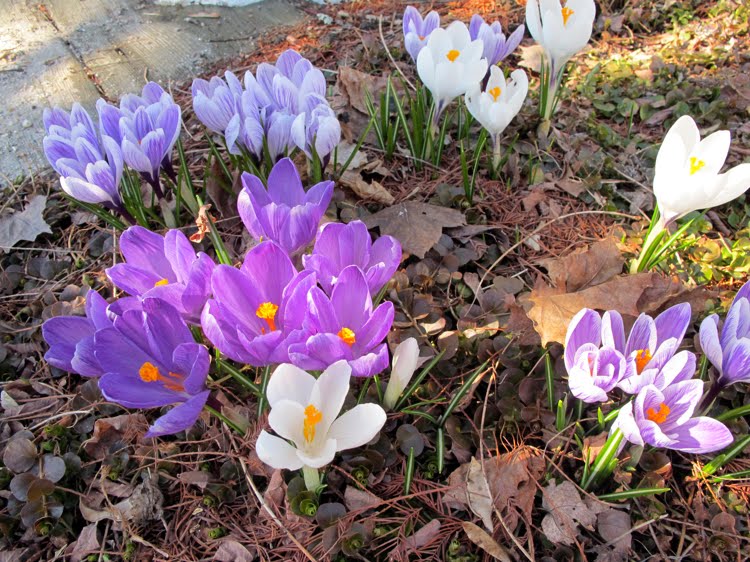
There are lots of bulbs that are not dug up and eaten by critters, with flowers that are not eaten by critters once they bloom. The tried-and-true are daffodils and alliums. Both of these types of bulbs naturalize and give a welcome early and later spring show.
Tips #1:

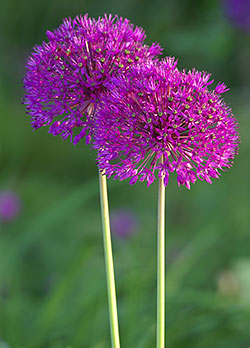
Allium 'Purple Sensation'

Allium thunbergii 'Alba'

Allium 'Graceful'

Allium cereuleum
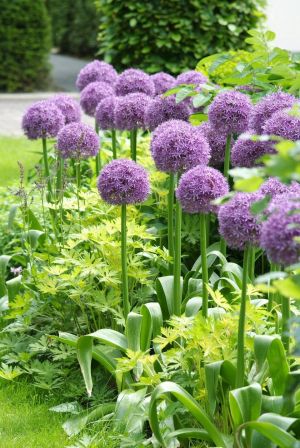
Tips #2:
Tips #3:


Don't put away your hose yet! We're having a meaningful rainfall deficit over the last two months, and plants that are going dormant need to do so in soil that has adequate moisture.
In September we had just over 2" of rainfall - the normal is just over 4".
In October we had 1.6" of rainfall - the normal is 4.5"
In other words, plants are "expecting" an inch of rain per week or thereabouts at this time of year. But they're falling behind. Extremely dry weather this fall is especially problematic for evergreens at a time when water is so critical for their health prior to winter. During the winter, exposed needles and leaves of evergreens are at the mercy of nature as cold winds pull moisture from the leaves. Once the ground freezes, the plant cannot bring any more water in through is roots. If water is lacking within the plant due to an abnormally dry fall season, needles and leaves may die as water is lost during harsh, winter conditions.
So keep the outdoor water on and a hose at the ready, even if your irrigation system has already been winterized. You certainly don't need to water every day, but once or a couple of times per week to make up for the inch of rain per week that the trees are not getting. Especially if they are newly-planted, with a limited root zone going into winter.
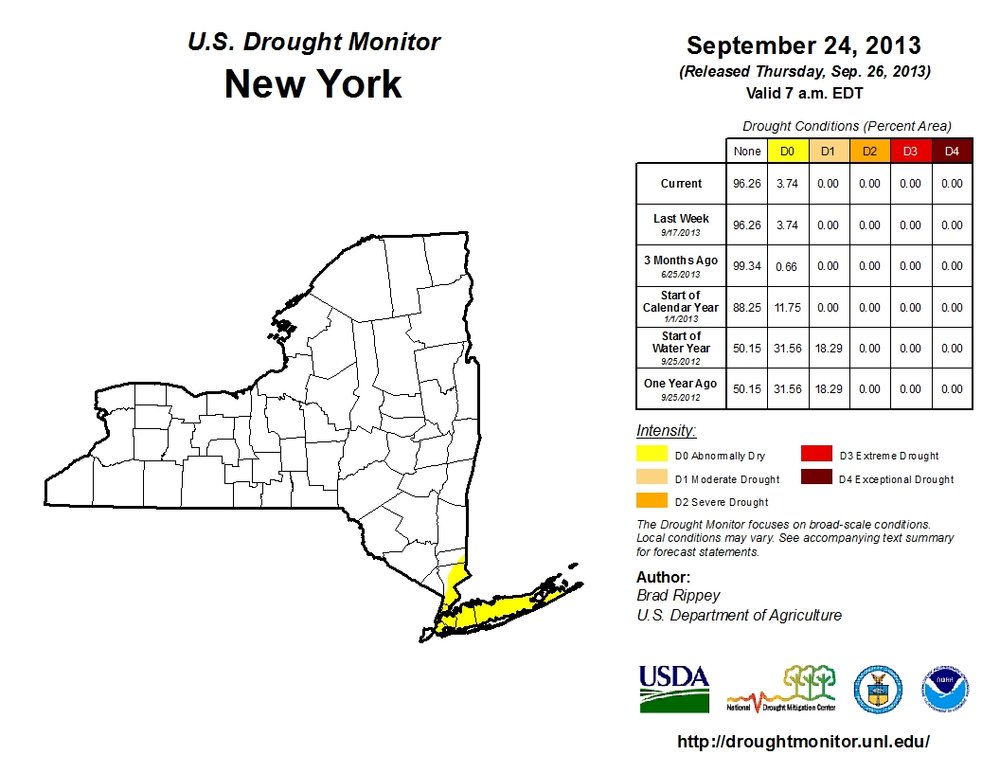
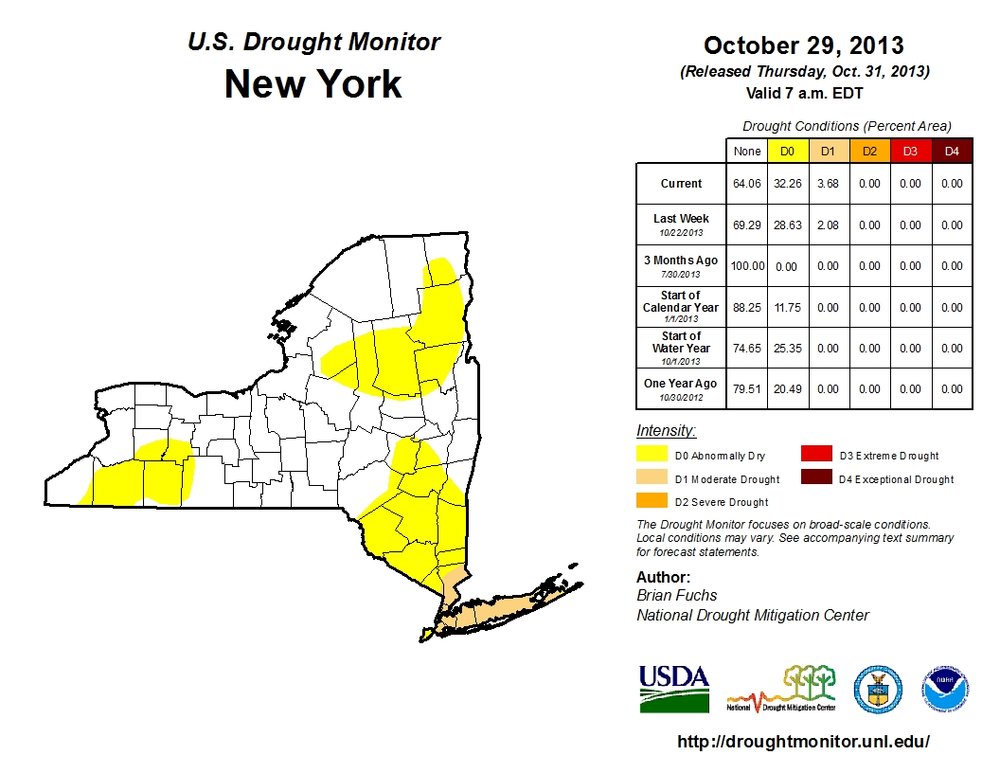
What I call a "mixed screening border" is a lot like a hedgerow. Hedgerows divide up farmers fields, and often consist of the "native" trees and shrubs that would be there if the fields weren't cultivated. Whatever you call them, this type of planting can provide vital resources for mammals, birds and insects. I like to think of them as hedgerows - it reminds me of Winnie the Pooh.
As well as being important habitats in their own right, hedgerows can act as wildlife corridors. They break the wind, attract beneficial insects and reduce pests. They provide privacy screens and reduce noise. Hedgerows can provide fruit, berries and nuts. They replace weeds or rows of arborvitae. Hedgerows help to hold water and reduce erosion. Hedgerows are a place where you can leave plant litter on the ground to provide valuable habitat for many invertebrates (who will in turn attract predators such as birds and bats) and cover for small mammals. In addition to all that, hedgerows are also beautiful.

The more diverse in composition a hedgerow is the more species it is likely to support due to a diversity of flowering and fruiting times.
There are quite a number of viburnums that can become part of your hedgerow. They have spring flowers, berries, beautiful fall color and most of them won’t outgrow the space. They do fine in part-shade (some even in deep shade). And berry set is best when several are planted near each other. You can have red, yellow, black or pink berries. Plant the fragrant varieties at the front or nearer the house so that you can smell the delicious fragrance wafting over you in spring.
Here are some viburnums that I've found to be interesting and "sturdy".
Viburnum dilatatum (Linden Viburnum) not only has wonderful fruiting in fall, but has some of the best foliage of any viburnum - large leaves, wrinkled and glossy, look great all summer, and they turn burgundy shades in fall. White flowers in June are followed by clusters of red or yellow berries which persist into winter. Two different V. dilatatum selections must be planted for berry set.
V. dilatatum 'Michael Dodge' has huge quantities of yellow berries that persist into winter. It's perfectly happy in shade. V. dilatatum 'Erie' is a smaller, rounded shrub with leaves that turn red, orange and yellow in fall. The unusual berries ripen red in summer, turn coral after the first frost, and persist as coral-pink berries throughout the winter. PHS Gold Medal Winner.

V. Dilatatum 'Erie' fall foliage
Viburnum plicatum var. tomentosum (Doublefile viburnum). The horizontal branches of Doublefile viburnum put on a spectacular May show, with flat white flowers marching down both sides of the stems (not in single file, but in double file). These strongly horizontal lines give Doublefile Viburnum a distinctive silhouette. The red fruit, which develops some years in midsummer, provides another show before being eaten by birds.
Viburnum plicatum v. tom. 'Copper Ridges' is a new introduction with beautiful foliage. Its leaves are full of character with conspicuous serrations and deeply impressed veins, and they often show a reddish blush in summer. The fall color is stunning: Initially copper with overtones of gold and red, it later changes to maroon. This chance seedling from the Seacrest Arboretum in Ohio appears to be a vigorous grower, reaching perhaps 6-8 feet.
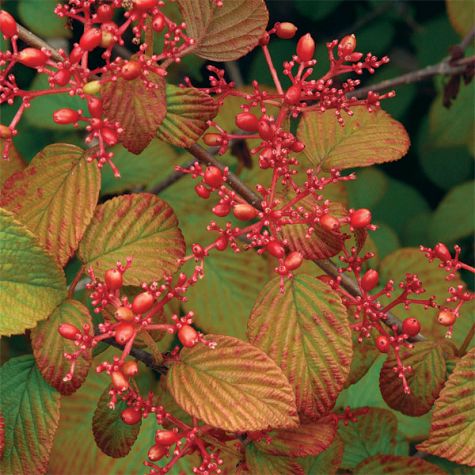
Doublefile berries
Viburnum rafinesquianum (Rafinesque Viburnum) is native to the woodlands of the East, Midwest, and into Canada - a medium-sized shrub with white flowers and glossy black berries. Supremely adaptable, it tolerates both heat and drought. While it is especially beautiful in a woodland setting, it does well in either sun or shade. Its glossy lance-shaped leaves turn a rich burgundy in fall.
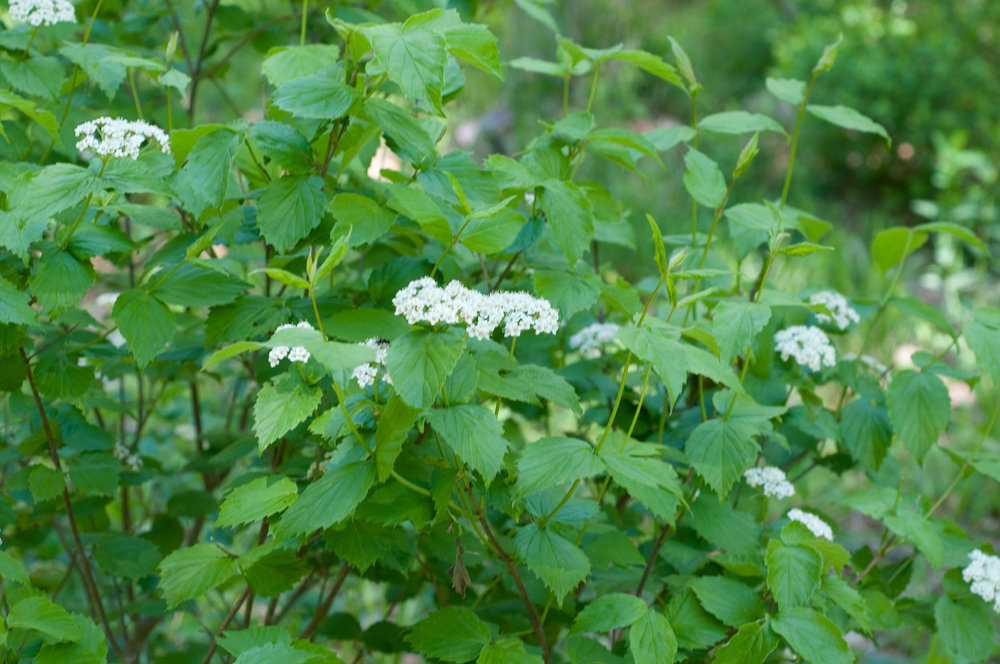
Rafinesque Viburnum flowers
Viburnum setigerum (Tea Viburnum). Clusters of scarlet berries are borne so heavily that the long branches often arch down with their weight. Reaches 8-12 feet in height and is ideal for the interior of a shrub border surrounded by smaller plants. The berries start out orangey-yellow and ripen to red.
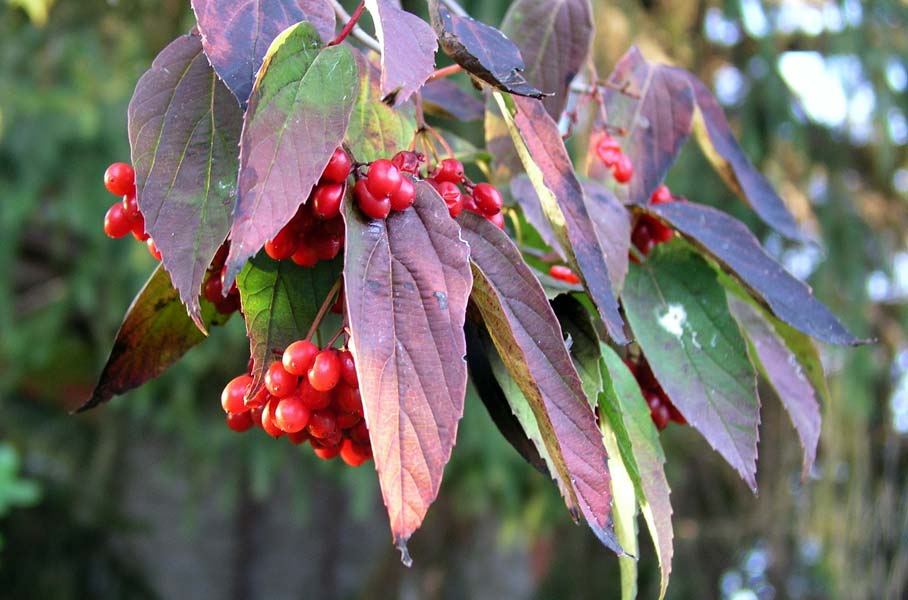
Tea Viburnum
And while you're at it, throw in a couple of Eastern Witchhazels!
Like
Hamamelis virginiana
'Mohonk Red' - Eastern Witchhazel. Yes, folks, a red-flowered Eastern Witchhhazel! Not the dark red seen on some hybrids, but a fine light red which shades to yellow at the tips of the petals. Flowers have a nice fragrance and open in mid-autumn along with the species. In his new book on Witchhazels, Chris Lane writes that there have been off-and-on sightings of red-flowered Eastern Witchhazels for over a century. This selection, discovered at the Mohonk Nature Preserve in New Paltz, NY, is probably the reddest one found so far. The shrub will grow to be about 15’ tall and 10’ wide.

Echinacea flowers are in heads (or cones) like sunflowers - these flowers are called disc florets. The drooping outer ray florets, which we think of as petals, attract insects visually but typically are sterile (don’t produce seeds or nectar). Instead, pollinators obtain pollen and nectar from individual disc florets. Since only small amounts of nectar are produced by a single floret, insects are enticed to visit more than one floret, and often more than one flowerhead per foraging trip in order to become satiated.
Here’s how that’s described scientifically: The cone-shaped capitulum of E. purpurea begins anthesis with the maturation of the outer, single whorl of sterile, ray florets, which surround multiple whorls of fertile, bisexual disc florets. Each disc floret is subtended by a bract, which gives the capitulum's center a “hedgehog”-like appearance. Disc florets mature sequentially, in whorls, from the periphery of the capitulum to the center, with one whorl of florets reaching anthesis (corolla opening) in the morning of each day.
Definitions:
Capitulum = a compact head of a structure, in particular a dense, flat cluster of small flowers or florets, as in plants of the daisy family.
Anthesis = the flowering period of a plant, from the opening of the flower bud.
Bract = a modified leaf or scale, typically small, with a flower or flower cluster in its axil. Bracts are sometimes larger and more brightly colored than the true flower, as in a poinsettia.
Subtended = (of a bract): extended under (a flower) so as to support or enfold it.
Inflorescence = the complete flower head of a plant including stems, stalks, bracts, and flowers.
Echinacea word origin = from Latin echīnātus prickly, from echīnus hedgehog

This is a picture of the disc florets - don't worry about the labels, you get the idea.
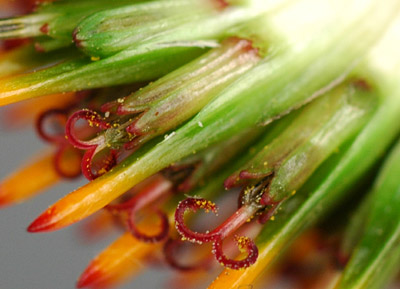
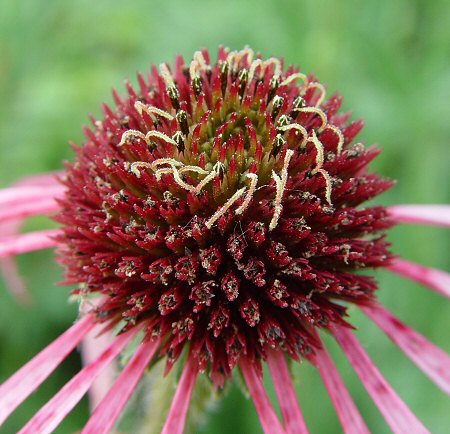
There are several species of Echinacea, including:
•E. pallida - Pale Coneflower, long and hanging pale-pink ray florets.
•E. paradoxa – Yellow Coneflower, with long hanging bright yellow ray florets and sturdy stems.
•E. purpurea - Purple Coneflower, originating in open woodlands and prairies, with ray floret colors ranging from pale-pink to dark blue-red.
•Some growers also add E. tennesseensis – Tennessee Coneflower, only known to exist naturally on certain glades near Nashville, Tennessee, and on the Federal Endangered Species List. Its ray florets are slightly upturned and the disc florets are coppery with a green tinge.
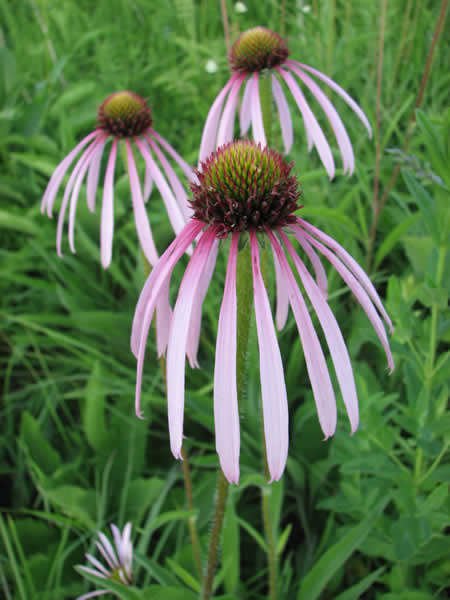
E. pallida

E.paradoxa

E. purpurea

E. tennesseensis
Most Echinacea species have taproots, making them difficult to transplant or grow in containers, and they resent poorly-drained soil. The exception is E. purpurea (Purple Coneflower), which grows in damp or even wet prairies and as a consequence has evolved a more forgiving fibrous root system that functions better in this type of soil. It has a further advantage in that its ray florets are wide and flat, not long and droopy, making it more showy.
E. paradoxa has yellow ray florets, and breeders realized that if they crossed this plant with E. purpurea, all manner of white, orange, red, purple and pink progeny result. The disc florets of the various Echinacea species can vary from dark burgundy, black, white, yellow or orange. Mixing and matching ray floret color and disc floret color has created some beautiful combinations. The characteristics that have been selected for by Echinacea hybridizers include:
Petalody = The metamorphosis of various floral organs, usually stamens, into petals.
Some of the “new” coneflowers are naturally-occurring cultivars – for example ‘Razzmatazz’, the first double cultivar, was discovered as a seedling in a Dutch cut flower field. Others are inter-specific hybrids, many between E. purpurea and E. paradoxa, some with a soupçon of E. tennesseensis thrown in. Then they can also be back-crossed with other seedlings to make different colors, doubles or dwarfs.
The most complicated part of Echinacea breeding is the self-incompatibility issue – a given Echinacea species is self-sterile; it doesn’t produce seed unless it is cross-pollinated. But wherever different species grow together, they hybridize. Echinacea allowed to self-seed in a garden is almost guaranteed to be hybrid if there are other echinaceas around. Thus, there’s a lot of naturally-occuring variation in coneflowers to begin with, which is good for selecting interesting cultivars, but once you select a hybrid that you want to propagate, it has to be done either vegetatively or in tissue culture. From a practical point of view, it also means that you should eliminate self-sown seedlings from your garden, because they won’t be “true” to the new and exciting hybrid that you want to grow.
Echinacea hybrids are quite sensitive to soil drainage conditions. Plugs can die fairly quickly if they’re wet for too long and sometimes those growing in pots can also die if they’re set out on landscape fabric without well-drained soil underneath. If spring rains come while the ground is still frozen lower down, the young plants often can’t survive the excess moisture and won’t come back. So when you’re looking for the right place to plant echinaceas in your garden, stick to the well-drained areas or create a slightly raised berm with a sand-rich soil mix.
Here are some of the newer cultivars:
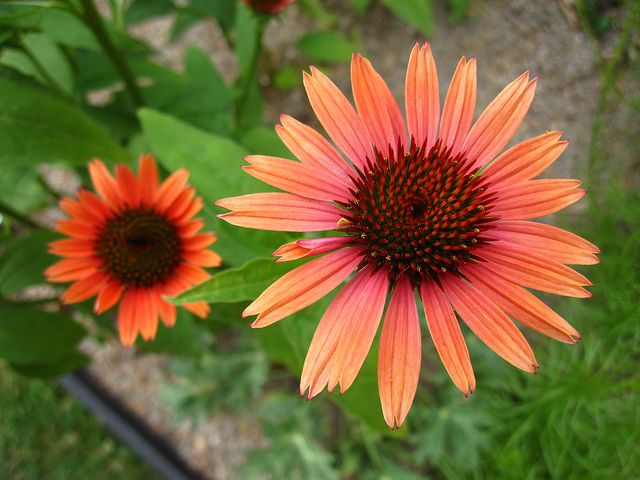
'Katie Saul' ('Summer Sky') is the first with bicolored ray florets and has a strong, sweet honey fragrance

'Tangerine Dream' has sweetly fragrant bright orange flowers
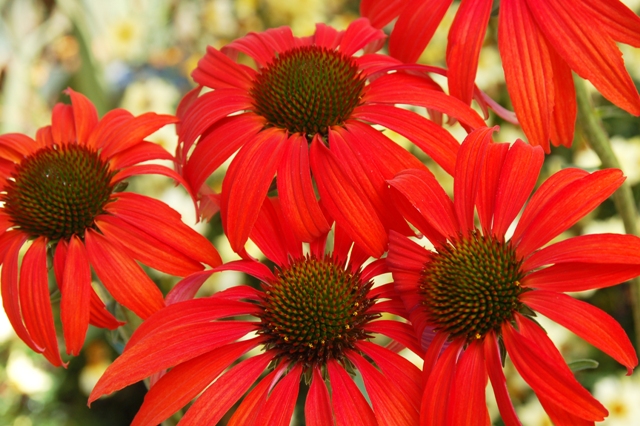
'Tomato Soup' has ray florets the color of - you guessed it - tomato soup!
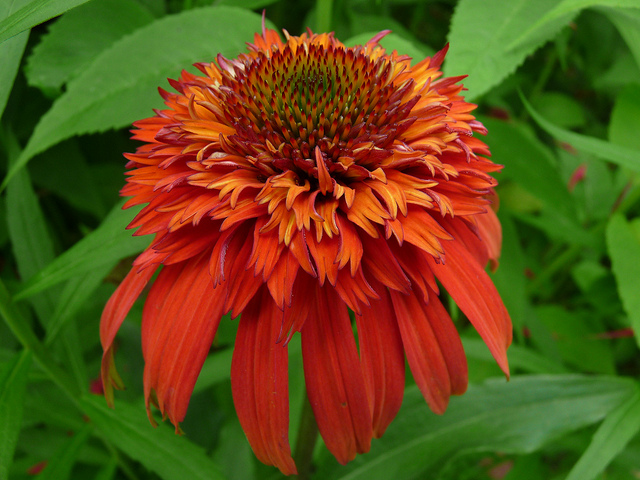
‘Hot Papaya’ takes double into a whole new world of color, with bright orange pom poms surrounded by a row of single drooping petals

‘Alaska’ an improved white-flowered form that is dwarf, sturdy and floriferous
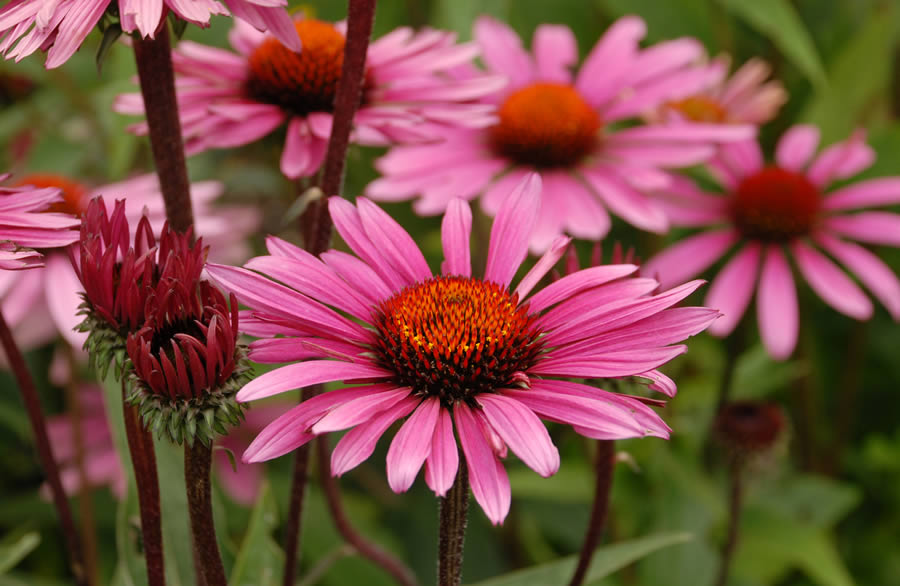
‘Fatal Attraction’ was bred by Piet Oudolf – say no more!
Inspired by plant lists and lectures by William Cullina, Head of the Coastal Main Botanical Gardens - check out his website:
www.williamcullina.com
Sassafras (Sassafras albidum) can rival even sugar maples in the beauty of its fall display. In the shade, the foliage becomes an intense golden yellow. When the tree is in more sun, leaves become scarlet, orange, and maroon. Sassafras is an opportunistic tree found commonly along unmanaged fence lines and power line right of ways where it can compete with larger trees. It sprouts readily from stumps and the sprouts grow rapidly, adding up to 3-4 feet in height each year for the first ten years. You may have never even seen sassafras flowers in early spring – but they’re a good nectar source for early pollinating insects.
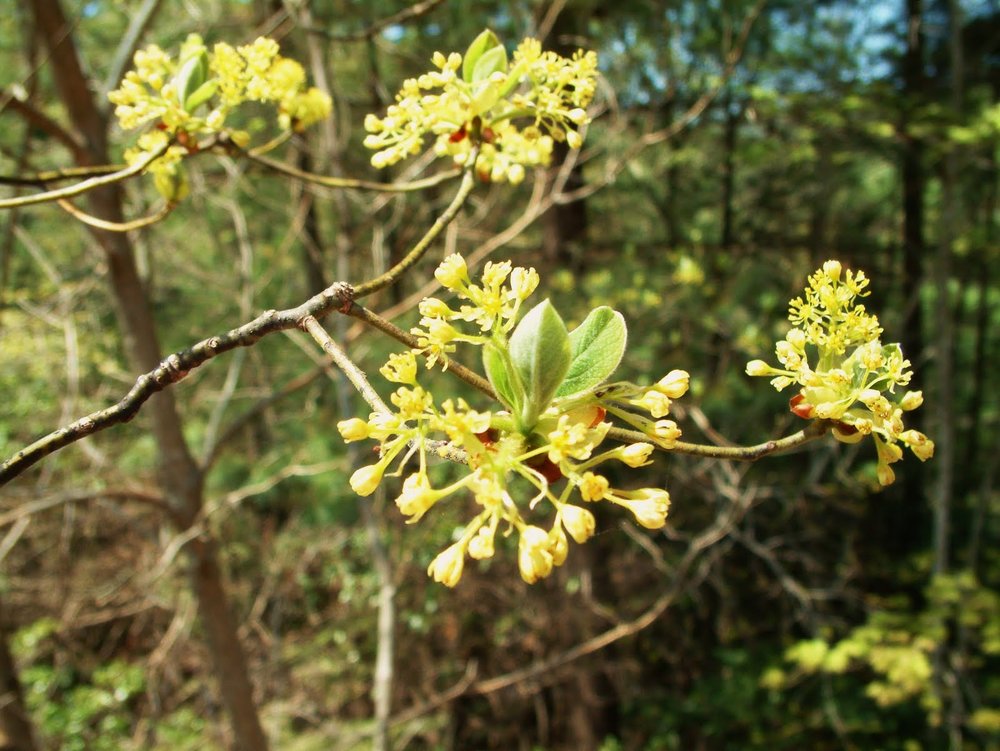
Sassafras flowers in early spring
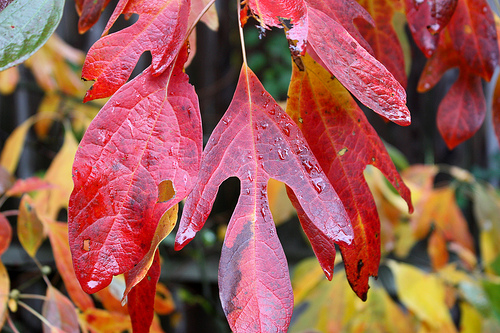
Sassafras fall color
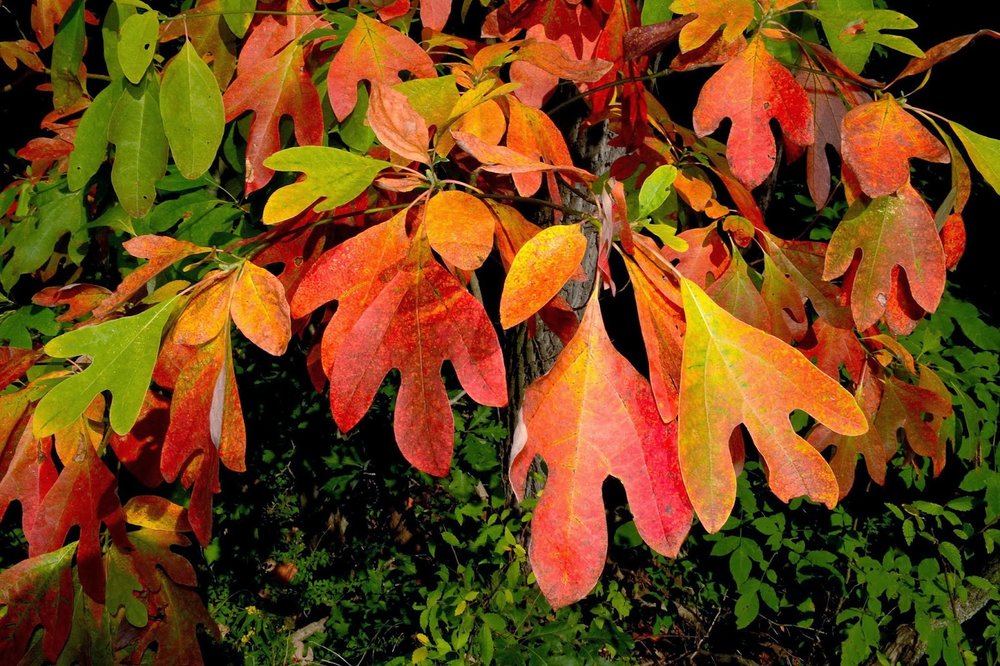
Sumac
There are two types of sumac that are nice additions to the landscape if you have good sun. One is ‘Gro-Low’ fragrant sumac (Rhus aromatica). ‘Gro-Low’ is a vigorous spreading groundcover (up to 2 ft tall with a spread of up to 8 ft), making it an excellent choice for stablizing a bank or smothering weeds. It has interesting fruits and a gorgeous orange-red fall color, and is deer resistant.
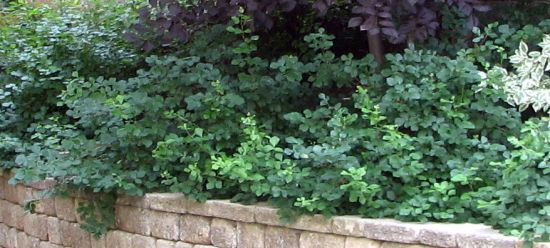
Rhus aromatica 'Gro-Low'
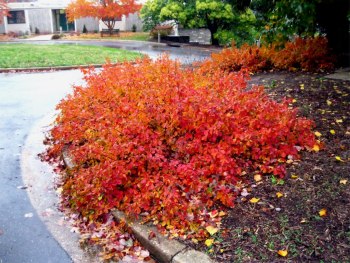
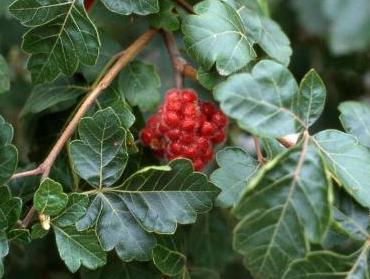
Rhus aromatica fruit
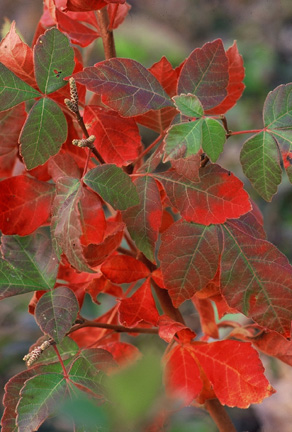
The other is ‘Tiger Eyes’ staghorn sumac (Rhus typhina ‘Tiger Eyes’ or ‘Bailtiger'), a dwarf, golden-leaved cultivar that typically matures to only 6’ tall and wide. It was discovered in a cultivated nursery setting as a whole plant mutation of R. typhina ‘Laciniata’ and is considered to be superior to both ‘Laciniata’ and the species because of its dwarf size, quality yellow foliage and minimal suckering. Deeply dissected compound leaves emerge chartreuse in spring, but quickly mature to bright yellow. Fall foliage is a striking mixture of orange and scarlet. It performs best in good sun. Since it can tend to become a bit leggy and spreads via suckers, its a good candidate for the back of the border, a naturalized stream bank or the wild garden (but not so much as a specimen).
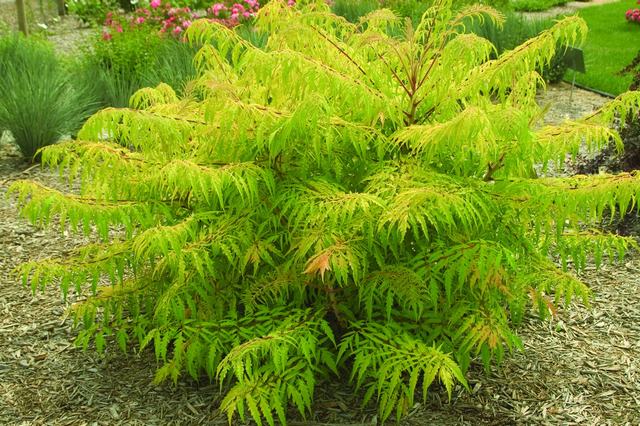
Rhus typhina 'Tiger Eyes'
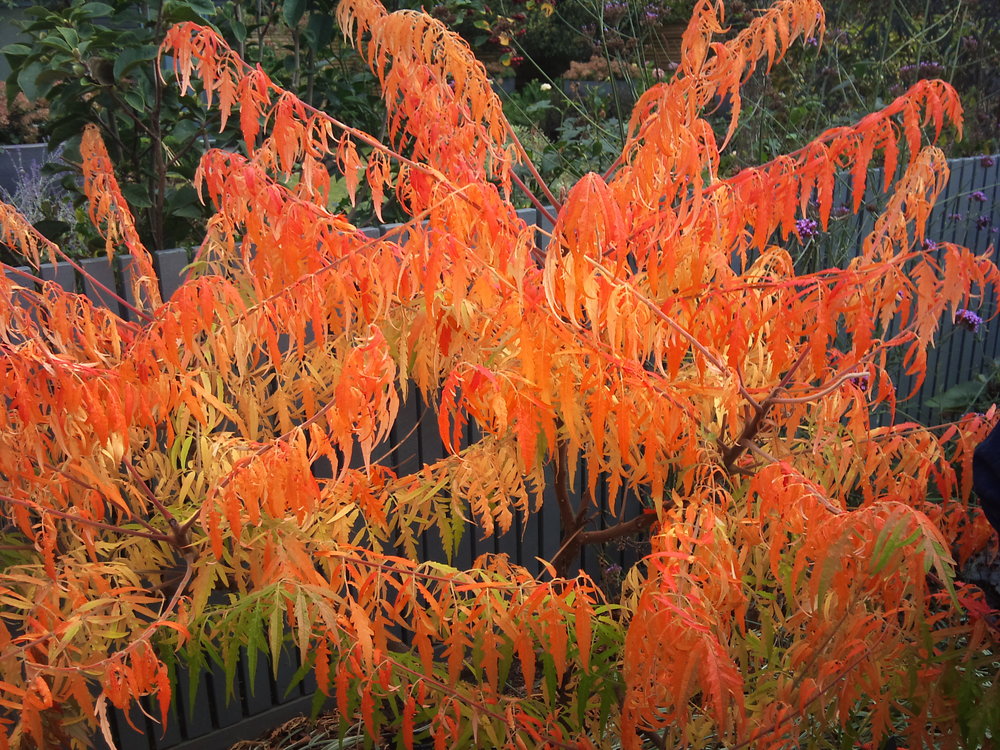
Rhus typhina fall color
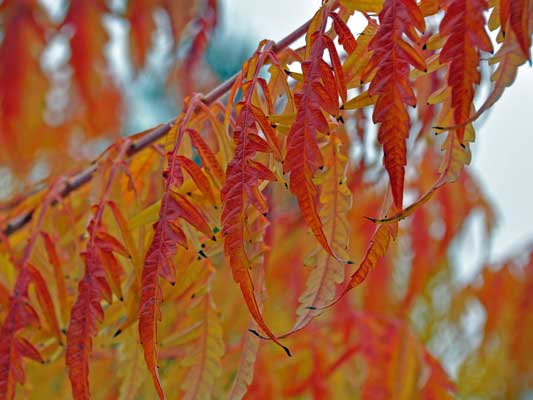
Wavy Hair-grass (Deschampsia flexuosa) is a clump-forming cool-season native grass that is not too large, takes some shade and has relatively showy flowers - it can fit into a mixed border quite well without overwhelming it. Like most ornamental grasses, it prefers well-drained soils. Its foliage is semi-evergreen in a mild winter. It's native to dry open woods, slopes, fields, grasslands and open areas, forming a low, dense tussock of very thin, arching green grass blades up to 2’ long. Flower stems rise in summer above the foliage mound bearing wide, airy panicles of tiny, purple to bronze flowers which form a cloud over the foliage that is attractive when backlit. Flower panicles turn gold after bloom as the seed ripens.
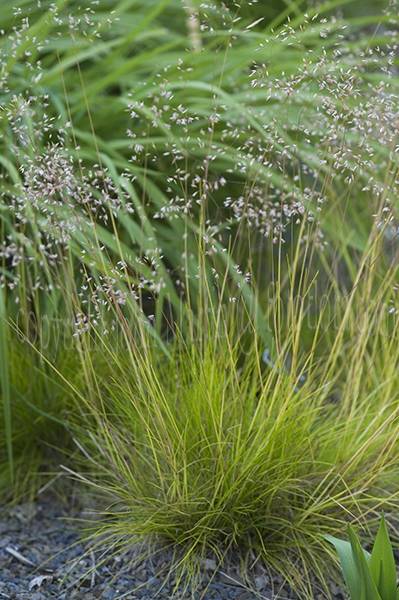
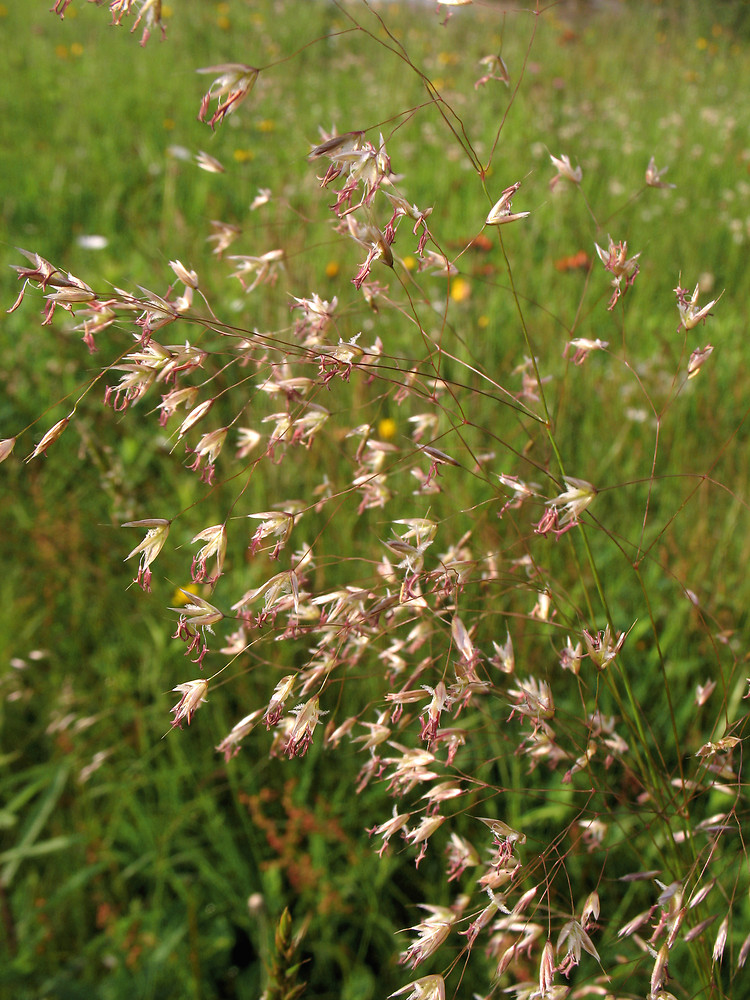
Smooth Witherod (Viburnum nudum) is native to low woods, swamps and bogs in the east and southeast, from Connecticut south to Florida and Louisiana. It can tolerate a wide variety of light conditions, from full sun to part shade and can also tolerate boggy conditions – a good candidate for a wettish area in the landscape. It has showy white flowers in spring – they don’t smell very good though! (For my nose, its definitely one of the “stinky” viburnums, but others don’t perceive it as smelling particularly bad). Flowers are followed by clusters of berries in late summer that change color as they ripen from light pink to dark pink to blue to purply-black. For best cross-pollination and subsequent fruit display, plant shrubs in groups rather than as single specimens. The best cultivar is ‘Winterthur’ – now fairly commonly available in the Nursery trade - a compact version, growing to about 6’ X 6’, with a reliably beautiful fall foliage color – maroon, dark red, purple. ‘Winterthur’, an introduction of Winterthur Gardens in Delaware, was a winner of the Pennsylvania Horticultural Society Gold Medal Award in 1991 – I guess that qualifies it as “tried and true” at this point!
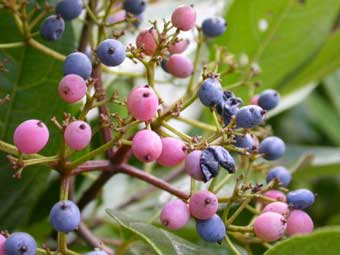
'Winterthur' berries ripening
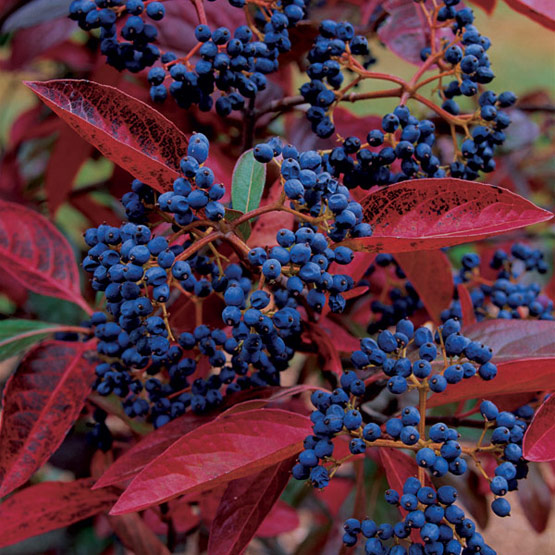
'Winterthur' ripe berries look beautiful with the fall foliage color
There's a disturbing trend out there in the world of declining trees in the landscape - stem girdling roots. These are roots that are strangling trees by wrapping around the buried part of the trunk. Sometimes you can see them, but more often than not you need to remove soil from the base of the tree before they're visible. Girdling roots make it difficult for nutrients and water to flow upward - they're like a tourniquet. The tree grows very slowly, it goes into premature decline, and the base of the trunk is weakened and can snap in a storm.
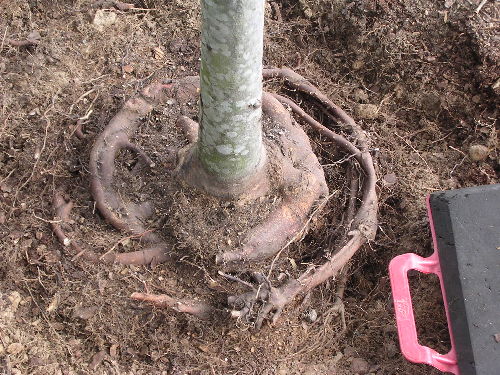
What causes girdling roots? Research over the last decade has shown that problems often originate in the nursery. Here's why: Most trees begin their lives in large nurseries that specialize in growing "liners" - trees of about 1" in caliper. Liners are then sold to regional nurseries where they're grown on to the sizes that we buy at our wholesale nurseries. Years ago, the liners were raised in fields and transplanted with bare roots. The grower could easily examine the roots and plant the tree properly with the main roots and trunk flare close to the surface of the soil. Now, containers are used at various stages of the growing process - field-grown trees are often started in containers. When a tree root reaches the wall of a container, it bends in a new direction to keep growing. Usually, this bend forces the root to grow in a circle along the container wall.
An additional common problem is when the trunk flare is buried under inches of soil. As lateral roots grow out of the buried part of the trunk, they can encircle the stem close to the surface. In field-grown trees, cultivation equipment used for weed management pushes soil against the trunk. With containers, roots may be buried when the root ball from the previous container is set too low and potting mix is added to top off the container.
What can we do?
The key is try your best not to plant trees with ill-formed roots. That means inspecting field-grown trees in the nursery to find the depth and distribution of a few main roots. Using garden tools, carefully dig around the base of the tree to ensure that the following criteria are met:
This type of inspection is non-invasive and doesn't harm the tree. It often may require that burlap be unwrapped from around the tree trunk - you should do this anyway, because you need to see the root flare, if possible, and inspect the trunk for any damage or evidence of rot or insects. Your wholesale supplier should have no reason to object to this, especially if you explain what you're doing and why. If you're not allowed to inspect, my advice would be to find a different supplier.
For containerized trees the inspection process is more difficult. At the nursery, you should be able to determine that the tree has been grown in the container long enough for the root system to be able to hold the potting medium together - but not so long as to have roots that are matted or circling around the edge of the root mass. At planting time, be certain to shave all circling roots on the exterior of the root mass deep enough so that all the cut ends are roughly radial to the trunk. This may add a little time, but will contribute to the ability of the tree to become established.
Some practitioners don't use containerized trees at all. This is because the possibility exists that there have been circling roots that were not pruned away before the tree was transferred to a larger container. A given tree could then have three sets of circling roots if it has been up-potted three times. Each set is further embedded in the root mass, and it's very hard to figure out if they're there.
Planting bare-root trees bypasses all of these problems, since you can see the whole root mass and prune as needed. But transporting and planting bare-root is tricky - make sure you understand the issues before you try it.

You may not know that wild bees pollinate a variety of crops, especially summer vegetable crops like tomatoes, peppers, blueberries, squash, melon and apples. They also supplement the activities of honey bees, which is increasing important when managed honey bee colonies are in a period of decline.
Who are these bees? And what do we need to do to conserve them?
Bumble bees (Bombus spp.) are considered to be the second-most important pollinators after honey bees. They can "buzz-pollinate" (vibrate the pollen off the anthers) - now you know why they're buzzing so loud - and they visit many crops that are not frequented by honey bees. Colonies are established each spring by a single queen.

Sweat bees (Halictus spp.) are small, short-tongued bees with metallic green-blue coloring. They are solitary and visit cane berries and onions.

Leafcutter bees (Megachile spp) are also solitary bees that nest in rotted wood and line their nests with pieces of leaves. The pieces they cut out are smooth circles. They pollinate melons.
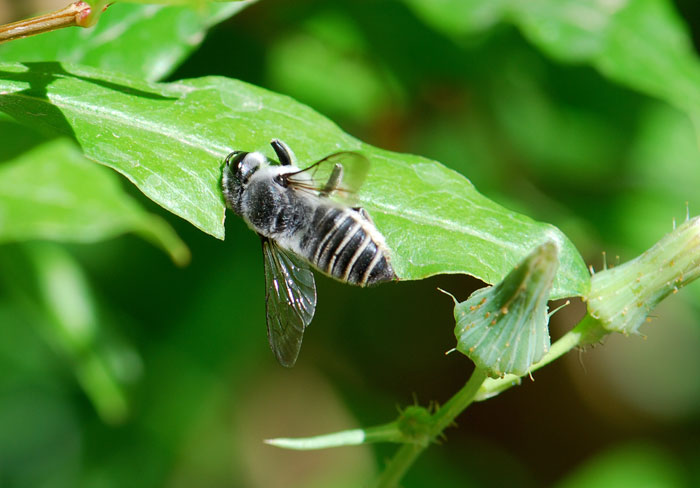
Squash bees (Peponapis pruinosa) are solitary ground-nesting bees that are efficient pollinators of cucumbers, melons, pumpkins and squash.
Mason bees (Osmia spp) are prized for their efficient pollination of fruit trees in spring.
You can conserve and attract wild bees to your landscapes by following these guidelines:



Some of Oudolf's favorite perennials include Amsonia hubrichtii (Perennial Plant of the Year for 2011), Stachys 'Hummelo', Sedum 'Sunkissed', Sedum 'Matrona', Rodgersia 'Die Anmutige' and Aruncus 'Horatio'.

Stachys 'Hummelo'
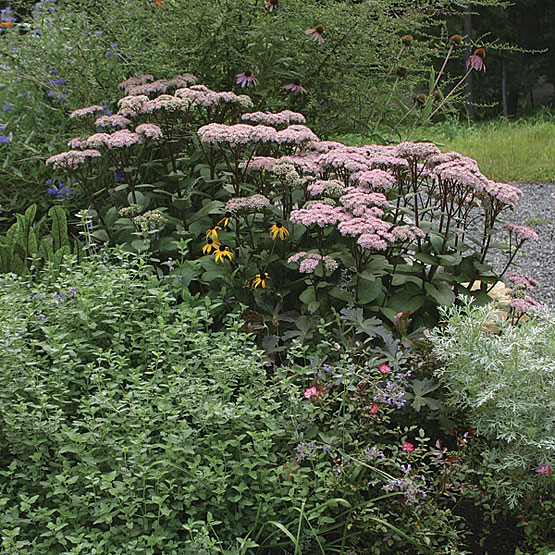
Sedum 'Matrona'
Oudolf himself has discovered and cultivated new varieties of perennials, including Echinacea 'Vintage Wine', Echinacea 'Virgin' and Salvia 'Eveline'.

Echinacea 'Virgin'
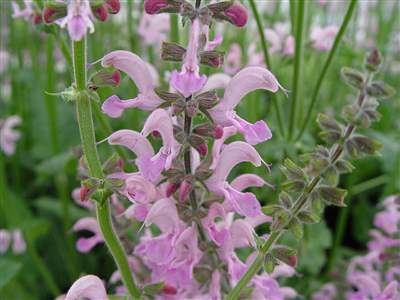
Salvia 'Eveline'
Oudolf planting plans are works of art in themselves. His plans are extremely detailed, with repeating motifs of heights, color and foliage that vary in scale and create a rhythm.
Use these perennials in your garden - if you have the right conditions, of course - and the only other things you'll need are a few shrubs and trees and some ornamental grasses.
"As the famous Dutch gardener Henk Gerritsen remarked in regard to Oudolf's work: "The plants look wild. The gardens do not.""
ONE: Rain gardens, vegetated swales, dry stream bed gardens - by whatever name (one potential client referred to it as a "glorified ditch") these stormwater management facilities are challenging and fun to design and implement. Especially in small spaces. My goal is to include stormwater management facilities in every design.
TWO: Water gardens - not as difficult as I thought they would be. It's been awe-inspiring to watch a 'Black Magic' colocasia grow from three small leaves into giant, beautiful gorgeousness, with runners spreading all over the place!
THREE: The challenge of improving the streetscape on Main Street - what are low-cost, creative ways to invest in making our Main Street business district more "beautiful" when there is no money available? And how do you convince "the people" that it's important enough to pay attention to? I installed two "mini-gardens' this fall in empty tree wells along Main Street to demonstrate that treating the tree well essentially like a container (perennials, a shrub or ornamental grass, some annuals and bulbs) can look (almost) as nice as a street tree (and certainly nicer than a mostly-dead tree or gravel!).
Mike Ruggerio, one of my favorite teachers from NYBG, basically knows everything about anything related to trees, shrubs, perennials, annuals and bulbs. His talks are always both funny and fascinating – you never fail to learn about a million new things. And you long to see what his own gardens are like!
This particular talk was on new perennials – new cultivars that fit his definition of a perennial – “a plant that comes back after more than two years” - meaning they are cold-hardy, adaptable, easy, beautiful and for the most part long-blooming – many also deer resistant.
I’ve chosen a few that I love too, or that I’m definitely going to try.

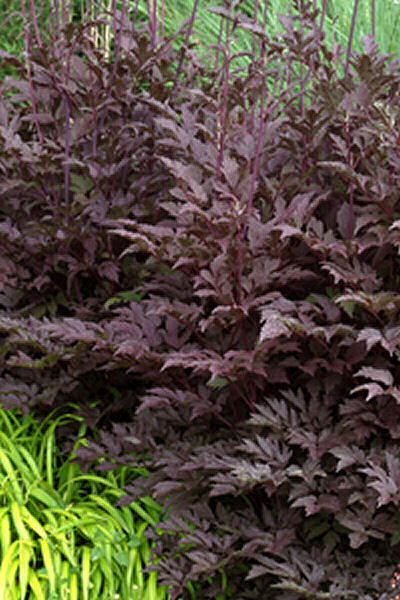
Black Negligee
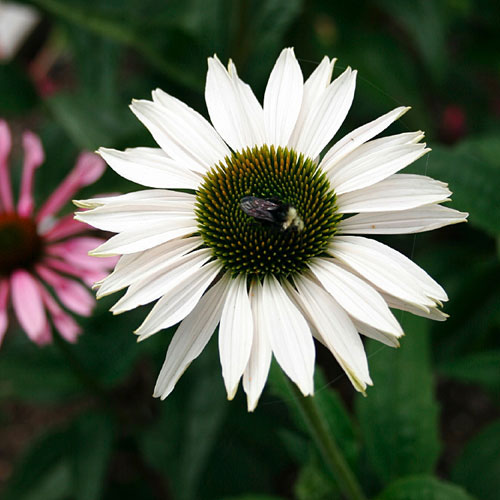
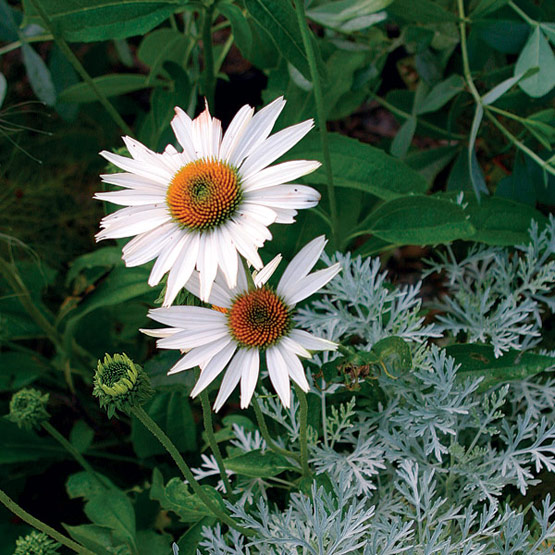

Hybrid daylily 'Barbara Mitchell'

Hybrid Daylily 'Bill Norris'


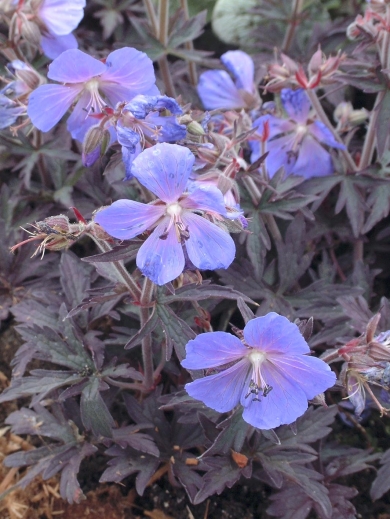


Copyright 2023 All rights reserved Ann Acheson Landscape Designs Inc